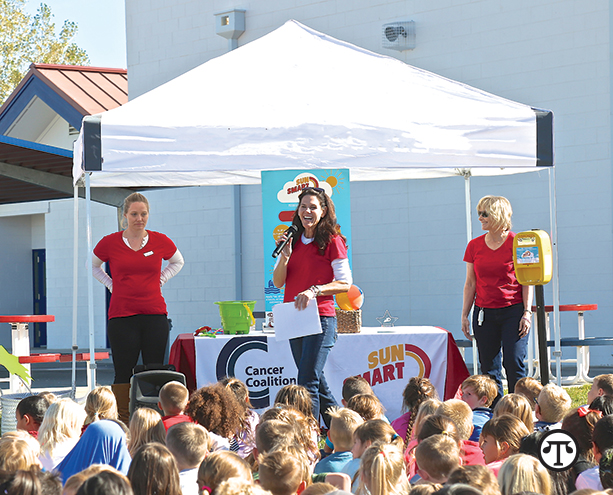
Nevada Cancer Coalition staff, Cari Herington (center) and Christine Thompson (right), and intern Bria Hosier (left) lead a Sun Smart Schools kickoff assembly at Gardnerville Elementary School in Douglas County.
(NAPSI)—
A Statewide Problem
There are about 76,000 new cases of melanoma—the deadliest kind of skin cancer—diagnosed every year. In 2018, around 800 of those will be diagnosed in Nevada. It’s a problem the Nevada Cancer Coalition (NCC) is determined to change, starting with the state’s youngest residents.
Prevention Starts Early
If a child gets even one severe (blistering) sunburn, it can double his or her risk of skin cancer later in life. The NCC program called Sun Smart Schools, started with CDC funding in 2015, is based on three “pillars” of sun safety: education, access to sunscreen and shade, and helping state officials understand that sun-safe policies could help decrease Nevada’s skin cancer problem in the next generation.
The first year of the program began with only seven schools. Students were given a small bottle of sunscreen to clip onto their backpacks. School nurses had a large bottle of sunscreen for refills, and each school gave lessons in sun safety developed by organizations like the Environmental Protection Agency and the Skin Cancer Foundation. Two surveys showed kids and families were changing their attitudes and actions on sun protection in a positive way.
From Pilot to Powerhouse
In the next school year, the program grew in a big way. Many more schools joined, including every single school in Douglas County. A partnership between NCC and a company that makes sunscreen dispensers helped move Sun Smart Schools to the next level. Instead of giving out bottles of sunscreen, many of the participating schools had a dispenser installed at the building so kids could get sunscreen any time during the day.
Schools in the program got materials for daily announcements such as information on the UV index and how the sun’s reflection from snow raises sunburn risk.
Partnership Means Everything
Soon, communities were getting on board. Staying in the shade is another good way to avoid UV exposure. Nurseries and tree farms near a few schools donated trees to help provide shade. Parent-teacher associations were holding fundraisers to buy and plant more.
“One of the things that really hits home for me every day is having key partners in every place,” says Christine Thompson, community programs manager for NCC.
2018 and Beyond
By the end of 2017, there were 55 sunscreen dispensers at 28 different schools. NCC expects that the dispensers, announcements, and lesson plans will be in 48 schools by spring of 2019.
To show that it’s never too late to think about sun protection, communities around the state—with the help of NCC—have started putting up sunscreen dispensers in public places like parks and swimming pools. Volunteers hand out samples of sunscreen and sun safety brochures at outdoor events year-round.
What You Can Do
No matter where in the country you live, you can lower your risk and your family’s risk for skin cancer by practicing sun safety. Some schools don’t allow students to carry over-the-counter medicines and creams such as sunscreen, so you can encourage kids to apply sunscreen before school, stay in the shade when playing outside, and wear wide-brimmed hats and sunglasses outside the school building.
Get in the habit of carrying many types of sun protection with you when you plan to be outside. Sunscreen works best when used with shade or protective clothing. Use sunscreen of at least SPF 15 on any exposed skin, and make sure to re-apply every two hours or after swimming, sweating, or toweling off.
Learn what CDC is doing to address skin cancer nationwide at www.cdc.gov/cancer/skin.
“Skin cancer is the most common cancer in the United States. One state’s Cancer Coalition helps kids learn how to protect their skin from the sun. Schools across the country can do the same. http://bit.ly/2qL0BK9”
